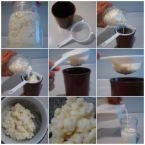The Basics
- A 500ml glass jar like a kilner jar
- About 1 tablespoon of kefir culture
- Fresh milk

Procedure:
Put the kefir culture in the glass jar, then fill it with fresh milk about 2/3 or so full.
Cover the jar with a cloth or put the lid on the jar.
(If you use a lid don't fill the jar above two thirds or use a jar with a rubber gasket that will let any pressure escape.)
Let the contents stand at room temperature for approx. 24 hours depending on your taste. 48 hours will make a thicker, sourer kefir, 12 hours a thinner, sweeter kefir.
The temperature will effect how quickly the culture works. So during the warm summer months the kefir will ferment faster.
When it's ready strain the kefir into a clean jar. While it's fermenting the kefir grains will float to the top of the milk along with any cream.
It's a good idea to stir it gently with a wooden spoon to mix up the solids and liquids to make it easier to strain. Or use a wooden spoon or clean hands to scoop out the culture from the kefir (the culture is easy to feel and separate from the liquids).
The kefir culture produces a jelly like polysaccharide substance that develops around the grains as they grow, making it look 'gloopy'.
It has unique properties and it's own name 'kefiran'. As you scoop out the grains you may find them coated with a gel like substance. This is the kefiran. Giving the kefir a good stir will distribute the kefiran in the kefir and it contributes to the thickness of the finished kefir. (This seems to be pretty variable, some strains producing a lot and others not much.)
After straining, the grains are placed straight back into a clean jar without washing them first. Fresh milk is added to the grains to make the next batch.
A Note on CleanlinessMake sure everything is very clean when handling kefir. It's a living culture, a complex system of bacteria and yeasts and you don't want risk contaminating it. Use freshly cleaned hands, clean jars and clean non metallic implements.
... Want to learn more ?
... Need Kefir Grains ?
Find below the Best Source to Know How To Make Kefir With Kefir Grains:
A Complete Video Course that Shows You Everything and More about How to Make Kefir Grains
+
Kefir Grains that will be shipped out in 1 to 2 business days.
An easy, reliable way to have fresh kefir whenever you desire...
Click Here To Get More Information About The Course :








